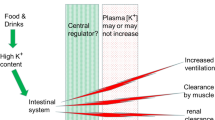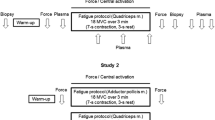Abstract
Accumulation of K+ in skeletal muscle interstitium during intense exercise has been suggested to cause fatigue in humans. The present study examined interstitial K+ kinetics and fatigue during repeated, intense, exhaustive exercise in human skeletal muscle. Ten subjects performed three repeated, intense (61.6±4.1 W; mean±SEM), one-legged knee extension exercise bouts (EX1, EX2 and EX3) to exhaustion separated by 10-min recovery periods. Interstitial [K+] ([K+]interst) in the vastus lateralis muscle were determined using microdialysis. Time-to-fatigue decreased progressively (P<0.05) during the protocol (5.1±0.4, 4.2±0.3 and 3.2±0.2 min for EX1, EX2 and EX3 respectively). Prior to these bouts, [K+]interst was 4.1±0.2, 4.8±0.2 and 5.2±0.2 mM, respectively. During the initial 1.5 min of exercise the accumulation rate of interstitial K+ was 85% greater (P<0.05) in EX1 than in EX3. At exhaustion [K+]interst was 11.4±0.8 mM in EX1, which was not different from that in EX2 (10.4±0.8 mM), but higher (P<0.05) than in EX3 (9.1±0.3 mM). The study demonstrated that the rate of accumulation of K+ in the muscle interstitium declines during intense repetitive exercise. Furthermore, whilst [K+]interst at exhaustion reached levels high enough to impair performance, the concentration decreased with repeated exercise, suggesting that accumulation of interstitial K+ per se does not cause fatigue when intense exercise is repeated.


Similar content being viewed by others
References
Andersen P, Adams RP, Sjögaard G, Thorboe A, Saltin B (1985) Dynamic knee extension as model for study of isolated exercising muscle in humans. J Appl Physiol 59:1647–1653
Bangsbo J, Graham T, Kiens B, Saltin B (1992) Elevated muscle glycogen and anaerobic energy production during exhaustive exercise in man. J Physiol (Lond) 451:205–227
Bangsbo J, Graham T, Johansen L, Strange S, Christensen C, Saltin B (1992) Elevated muscle acidity and energy production during exhaustive exercise in man. Am J Physiol Physiol 263:R881–R899
Bangsbo J, Madsen K, Kiens B, Richter EA (1996) Effect of muscle acidity on muscle metabolism and fatigue during intense exercise in man. J Physiol (Lond) 495:587–596
Bangsbo J, Krustrup P, Gonzáles-Alonso J, Saltin B (2001) ATP production and efficiency of human skeletal muscle during intense exercise: effect of previous exercise. Am J Physiol 208:E956–E964
Cairnes SP, Dulhunty AF (1995) High-frequency fatigue in rat skeletal muscle: role of extracellulary ion concentrations. Muscle Nerve 18:890–898
Cairnes SP, Hing WA, Slack JR, Mills RG, Loiselle DS (1997) Different effects of raised [K+] on membrane potential and contraction in mouse fast- and slow-twich muscle. Am J Physiol 273:C598–C611
Davies NW (1990) Modulation of ATP-sensitive K+ channels in skeletal muscle by intracellular protons. Nature 343:375–377
Davies NW, Standen NB, Stanfield PR (1991) ATP-dependent potassium channels of muscle cells: their properties, regulation and possible functions. J Bioenerg Biomembr 23:509–523
Fitts RH (1994) Cellular mechanisms of muscle fatigue. Physiol Rev 74:49–94
Fitts RH, Balog EM (1996) Effects of intracellular and extracellular ion changes on E-C coupling and skeletal muscle fatigue. Acta Physiol Scand 156:169–181
Gaitanos GC, Williams C, Boobis LH, Brooks S. (1993) Human muscle metabolism during intermittent maximal exercise. J Appl Physiol 75:712–719
Hellsten Y, Richter EA, Kiens B, Bangsbo J (1999) AMP deamination and purine exchange in human skeletal muscle during and after intense exercise. J Physiol (Lond) 520:909–920
Hocherman SD, Bezanilla F (1996) A patch-clamp study of delayed rectifier currents in skeletal muscle of control and mdx mice. J Physiol (Lond) 493:113–128
Jones PR, Pearson J (1969) Antrophometric determination of leg fat and muscle plus bone volumes in young male and female adults. J Physiol (Lond) 204:63P–66P
Juel C (1988) The effect of beta 2-adrenoceptor activation on ion-shifts and fatigue in mouse soleus muscle stimulated in vitro. Acta Physiol Scand 134:209–216
Juel C, Bangsbo J, Graham T, Saltin B (1990) Lactate and potassium fluxes from human skeletal muscle during and after intense, dynamic, knee extensor exercise. Acta Physiol Scand 140:147–159
Juel C, Pilegaard H, Nielsen JJ, Bangsbo J (2000) Interstitial K+ in human skeletal muscle during and after dynamic graded exercise determined by microdialysis. Am J Physiol 278:R400–R406
Juel C, Nielsen JJ, Bangsbo J (2000) Exercise induced translocation of Na+,K+ pump subunits to the plasma membrane in human skeletal muscle Am J Physiol 278:R1107–R1110
Juel C, Grunnet L, Holse M, Kenworthy S, Sommer A, Wulff T (2001) Reversibility of exercise-induced translocation of Na+-K+ pump subunits to the plasma membrane in rat skeletal muscle. Pflugers Arch 443:212–217
Kristensen M, Hellsten Y, Juel C (2002) Potassium channels involved in potassium release from active skeletal muscle (abstract). FASEB J 16:609–609
Krustrup P, González-Alonso J, Quistorff B, Bangsbo J (2001) Muscle heat production and anaerobic energy turnover during repeated intense dynamic exercise in humans. J Physiol (Lond) 536:947–956
Lowry OH, Passonneau JV (1972) A flexible system of enzymatic analysis. Academic Press, New York
Medbø JI, Sejersted OM (1990) Plasma potassium changes with high intensity exercise. J Physiol (Lond) 421:105–122
Nielsen JJ, Kristensen M, Hellsten Y, Bangsbo J, Juel C (2003) Localization and function of ATP-sensitive potassium channels in human skeletal muscle. Am J Physiol 284:R558–R563
Nordsborg N, Mohr M, Danneman LD, Nielsen JJ, Langberg H, Bangsbo J (2003) Muscle interstitial potassium kinetics during intense exhaustive exercise—effect of previous arm exercise. Am J Physiol 285:R143–R148
Radegran G, Pilegaard H, Nielsen JJ, Bangsbo, J (1998) Microdialyse ethanol removal reflects probe recovery rather than local blood flow in skeletal muscle. J Appl Physiol 85:751–757
Ruff RL, Simoncini L, Stuhmer W (1988) Slow sodium channel inactivation in mammalian muscle: a possible role in regulating excitability. Muscle Nerve 11:502–510
Sejersted OM, Sjögaard G (2000) Dynamics and consequences of potassium shifts in skeletal muscle and heart during exercise. Physiol Rev 80:1411–1481
Sjögaard G (1983) Electrolytes in slow and fast muscle fibers of humans at rest and with dynamic exercise. Am J Physiol 245:R25–R31
Sjögaard G, Adams P, Saltin B (1985) Water and ion shifts in skeletal muscle of humans with intense dynamic knee extensions. Am J Physiol 248:R190–R196
Spriet LL, Lindinger MI, McKelvie RS, Heigenhauser GJ, Jones NL (1989) Muscle glycogenolysis and H+ concentration during maximal intermittent cycling. J Appl Physiol 66:8–13
Spruce AE, Standen NB, Standfield PR (1985) Voltage-dependent ATP-sensitive potassium channels of skeletal muscle membrane. Nature 316:736–738
Sréter FA (1963) Cell water, sodium and potassium in stimulated red and white mammalian muscle. Am J Physiol 205:1295–1298
Standen NB, Pettit AI, Davies NW, Stanfield PR (1992) Activation of ATP-dependent K+ currents in intact skeletal muscle fibres by reduced intracellular pH. Proc R Soc Lond B Biol Sci 247:195–198
Vøllestad NK, Hallen J, Sejersted OM (1994) Effect of exercise intensity on potassium balance in muscle and blood of man. J Physiol (Lond) 475:359–368
Acknowledgements
The excellent technical assistant of Ingelise Kring, Merete Vannby and Winnie Taagerup is greatly appreciated. The study was supported by a grant from The Danish National Research Foundation (504-14). In addition support was obtained from The Sports Reasearch Council (Idraettens Forskningsråd) and Team Denmark.
Author information
Authors and Affiliations
Corresponding author
Rights and permissions
About this article
Cite this article
Mohr, M., Nordsborg, N., Nielsen, J.J. et al. Potassium kinetics in human muscle interstitium during repeated intense exercise in relation to fatigue. Pflugers Arch - Eur J Physiol 448, 452–456 (2004). https://doi.org/10.1007/s00424-004-1257-6
Received:
Revised:
Accepted:
Published:
Issue Date:
DOI: https://doi.org/10.1007/s00424-004-1257-6




